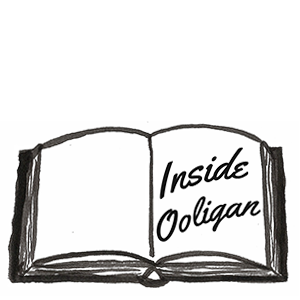The graduate publishing program at PSU is unique for many reasons. Yes, students take classes and earn credits toward their degrees like they would in any other program, but that’s only one aspect of the Ooligan experience. Incoming Oolies are often overwhelmed by references to pitches, copy, sales kits, trim size, comp titles (not to be confused with cover comps), and P&Ls. Seasoned Ooligan students use this lingo on a regular basis because they are not only takingclasses to learn how to make books—they’re actually making books. For anyone not involved with Ooligan, the term “student press” might be accompanied by visions of heavy-handed oversight from supervisors, and it may be hard to connect it to the academic endeavor that is a graduate program. For an Ooligan student, however, it’s all in a day’s work.
Acquisitions Process
During the acquisitions stage, a small group of Ooligan students read and evaluate each submitted project query, proposal, or manuscript for relevance to the Ooligan mission and for interesting subject matter and quality of writing. Projects are evaluated by multiple Ooligan students, and when the majority agrees that the project is worth pursuing, it is advanced to the pitch development stage.
A pitch team then determines a base set of specifications for the book, including page count, binding style, size, and illustrations or photographs. The group researches recent comparable titles (comp titles) that feature the same subject matter or a closely related topic and collects sales numbers for those titles. A preliminary marketing plan, detailing ways that the finished product might be publicized and marketed to its specific audiences, is included. Using the initial specs, the team submits requests for print bids to multiple printers in order to collect competitive costs for the project. Based on the returned print bids and the projected pricing of the book, the pitch team develops preliminary costing.
After all of this research has been done, the pitch is presented during an Ooligan executive meeting. All students are informed of this time and encouraged to attend. After the pitch, Oolies ask any questions they may have, and a vote is taken, determining whether the press will acquire or pass on the project. Once a project has been acquired by vote, the publisher will meet with the author or editor, and royalties are negotiated, a production schedule and timeline is established, and a contract is evaluated and signed by both parties.
Project Team’s Process
Every acquired project is assigned to a team that oversees each stage of development as the book moves through editing, design, and marketing. Each stage is collaborative in nature and includes the oversight of a project manager, department heads, and the publisher to maintain focus and direction for the project.
The project team decides if developmental editing is required and then collaborates with the author to address any global issues in the manuscript. After developmental editing, copyediting takes place; the project group and the Ooligan editorial department work as a team to carefully process the manuscript, using standard publishing industry approaches to create consistency with regard to mechanics, story, tone, and permissions.
Once the manuscript has been edited, the project is moved into the design phase. Members of the project team work with the design department to select an interior design schema. The project team generates a design brief, which includes an overview of the desired goals for the cover of the book. These goals include how the final cover will represent the content, engage the target audience, and generate interest. The design brief is distributed to all of the Ooligan Press members, who each have the opportunity to create and submit a potential cover. The final covers are presented during an executive meeting, and a vote is held and the final cover is selected. The final interior design and cover design are then submitted to the printer.
The project team also develops sales materials and a marketing plan. To build the plan, a list of resources that will be useful during the marketing stage is created, including potential reviewers, media outlets that might be interested in the book, and social media outlets that can be utilized to market the book. Potential launch or reading venues are identified, and distinctive aspects of the book’s content or author are evaluated for potential marketing avenues—events that revolve around the content, the author’s personal and professional networks, or special occasions that are related to the book.
Promotion of a new book begins long before the date of publication. Tip sheets that include the book’s specs are provided to Ooligan’s distributor so they can start generating interest in the title. Original sales kits are designed for each project and used as a way to present the book to potential media resources. Resources from the marketing plan are contacted, and Ooligan’s social media platforms are used to generate awareness of the project and to spread the word about important dates and events.
Launch Process
Once the book is printed, Ooligan works with its distributor to ensure that the title is available through relevant market avenues, including chain bookstores, independent bookstores, and online markets. The project team continues to oversee the project beyond its printing. With the marketing department, they work to arrange launch events, readings, or other marketing efforts that are designed to generate awareness of the title and to facilitate sell-through. The project team also works to provide the author with the necessary tools to promote the book through their own networks and social media channels.
This in-depth process details what is so extraordinary about the publishing program at PSU. Not only do students learn skills applicable to the publishing industry through the classes offered, but every student participates in multiple aspects of the processes described above, thereby learning the practical application of those skills.

